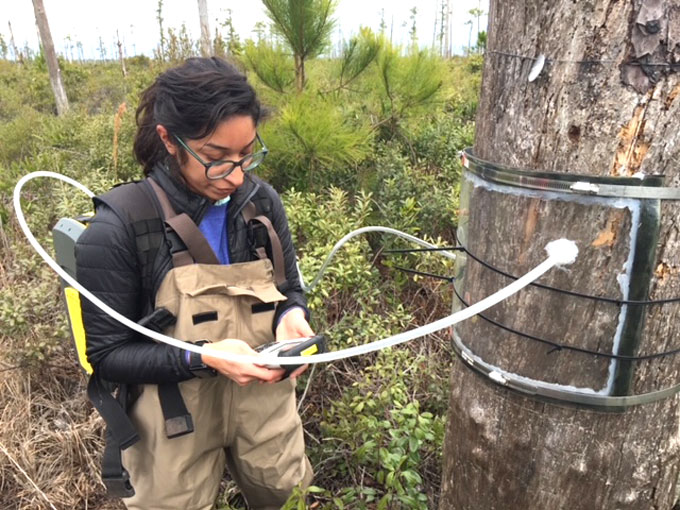If a tree farts in the forest, does it make a sound? No, but it does add a smidge of greenhouse gas to the atmosphere.
Gases released by dead trees — dubbed “tree farts” — account for roughly one-fifth of the greenhouse gases emitted by skeletal, marshy forests along the coast of North Carolina, researchers report online May 10 in Biogeochemistry. While these emissions pale in comparison with other sources, an accurate accounting is necessary to get a full picture of where climate-warming gases come from.
A team of ecologists went sniffing for tree farts in ghost forests, which form when saltwater from rising sea levels poisons a woodland, leaving behind a marsh full of standing dead trees. These phantom ecosystems are expected to expand with climate change, but it’s unclear exactly how they contribute to the world’s carbon budget.
“The emergence of ghost forests is one of the biggest changes happening in response to sea level rise,” says Keryn Gedan, a coastal ecologist at George Washington University in Washington, D.C., who was not involved in the work. “As forests convert to wetlands, we expect over long timescales that’s going to represent a substantial carbon sink,” she says, since wetlands store more carbon than forests. But in the short term, dead trees decay and stop taking up carbon dioxide through photosynthesis, “so that’s going to be a major greenhouse gas source.”

Sign Up For the Latest from Science News
Headlines and summaries of the latest Science News articles, delivered to your inbox
Client key* E-mail Address* Go
Thank you for signing up!
There was a problem signing you up.
To better understand how ghost forests pass gas into the atmosphere, the researchers measured greenhouse gases wafting off dead trees and soil in five ghost forests on the Albemarle-Pamlico Peninsula in North Carolina. “It’s kind of eerie” out there, says Melinda Martinez, a wetland ecologist at North Carolina State University in Raleigh.
But Martinez ain’t afraid of no ghost forest. In 2018 and 2019, she measured CO2, methane and nitrous oxide emissions from dead trees using a portable gas analyzer she toted on her back. “I definitely looked like a ghostbuster,” she says.
 Wetland ecologist Melinda Martinez totes a portable gas analyzer on her back to measure the “tree farts” emitted by a ghost forest tree. A tube connects the gas analyzer to an airtight seal around the trunk of the tree.M. Ardón
Wetland ecologist Melinda Martinez totes a portable gas analyzer on her back to measure the “tree farts” emitted by a ghost forest tree. A tube connects the gas analyzer to an airtight seal around the trunk of the tree.M. Ardón
Soils gave off most of the greenhouse gases from the ghost forests. Each square meter of ground emitted an average 416 milligrams of CO2, 5.9 milligrams of methane and 0.1 milligrams of nitrous oxide per hour. On average, dead trees released about 116 milligrams of CO2, 0.3 milligrams of methane and 0.04 milligrams of nitrous oxide per square meter per hour — totaling about one-fourth the soil’s emissions.
Measuring greenhouse gases from the trees is “kind of measuring the last breath of these forests,” says Marcelo Ardón, an ecosystems ecologist and biogeochemist at North Carolina State University. The dead trees “don’t emit a ton, but they are important” to a ghost forest’s overall emissions.
Ardón coined the term “tree farts” to describe the dead trees’ greenhouse gas emissions. “I have an 8-year-old and an 11-year-old, and fart jokes are what we talk about,” he explains. But the analogy has a biological basis, too. Actual farts are caused by microbes in the body; the greenhouse gases emitted by ghost forests are created by microbes in the soil and trees.
In the grand scheme of carbon emissions, ghost forests’ role may be minor. Tree farts, for instance, have nothing on cow burps (SN: 11/18/15). A single dairy cow can emit up to 27 grams of methane — a far more potent greenhouse gas than CO2 — per hour. But accounting for even minor sources of carbon is important for fine-tuning our understanding of the global carbon budget, says Martinez (SN: 10/1/19). So it would behoove scientists not to turn up their noses at ghost tree farts.

